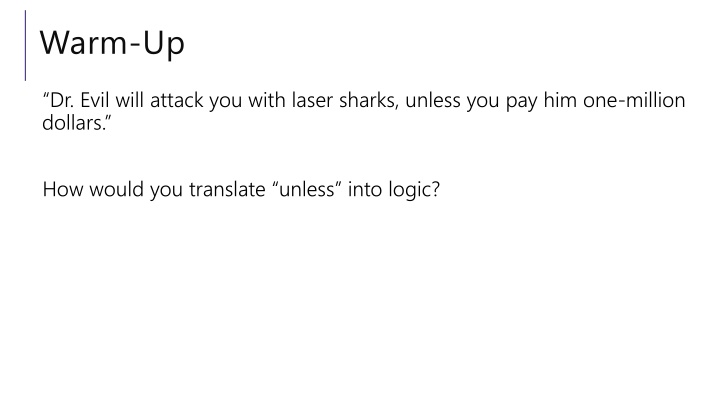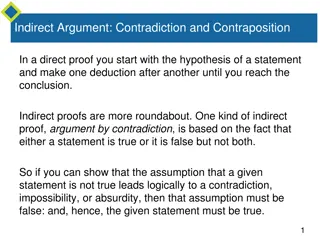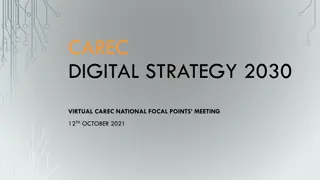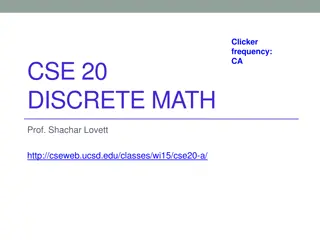
Logical Translation of "Unless" into Dr. Evil Scenario
In a scenario involving Dr. Evil and his laser sharks, the concept of "unless" is translated into logic to determine the outcome of either paying him one million dollars or facing the attack of the laser sharks. The logical implications and consequences are explored to understand the conditions for safety in this peculiar situation.
Download Presentation

Please find below an Image/Link to download the presentation.
The content on the website is provided AS IS for your information and personal use only. It may not be sold, licensed, or shared on other websites without obtaining consent from the author. If you encounter any issues during the download, it is possible that the publisher has removed the file from their server.
You are allowed to download the files provided on this website for personal or commercial use, subject to the condition that they are used lawfully. All files are the property of their respective owners.
The content on the website is provided AS IS for your information and personal use only. It may not be sold, licensed, or shared on other websites without obtaining consent from the author.
E N D
Presentation Transcript
Warm-Up Dr. Evil will attack you with laser sharks, unless you pay him one-million dollars. How would you translate unless into logic?
Warm-Up Solution Dr. Evil will attack you with laser sharks, unless you pay him one-million dollars. If you pay Dr. Evil his one-million dollars, are you safe from the laser sharks? This is Dr. Evil! He hasn t promised you that s his full full list of demands. If you do not pay Dr. Evil one-million dollars, then he will attack you with laser sharks. Is the only promise you really have.
Warm-Up Solution Dr. Evil will attack you with laser sharks, unless you pay him one-million dollars. ?: Dr. Evil will attack you with laser sharks ?: You pay him one-million dollars The last slide would give us: ? ? If Dr. Evil doesn t attack you with laser sharks, you must have paid him his million dollars, right? ? ? Are those both good translations?
xkcd.com/1153 Our First Proof and Digital Logic CSE 311 Fall 2020 Lecture 3
Today 10 minutes of syllabus Our first proof! Contrapositives and digital logic.
Announcements Homework 1 Problem 6 clarified (download a new version of the pdf). Office Hours start this week.
Office Hours A chance to talk to staff about the class. Advice: You don t have to have a question to come to office hours! (It can help, though) Aim as early in the week as possible. We won t answer every kind of question in office hours: We don t pregrade homework. We won t tell you whether something is right or wrong. We will help on homework, but not usually by giving hints. We ll usually ask questions about what you ve tried, ask questions to help you decide what to do next, or point you to good examples to look at. You re allowed to talk to others at office hours, as long as you re still following the collaboration policy.
Homework Submissions Make sure we can read what you submit. We can t spend 5 minutes per submission deciding if that s a ? or a ?. Typesetting guarantees we can read it. Microsoft Word s equation editor is now halfway decent! LaTeX is the industry standard for typesetting (if you go to CS grad school, you ll use it for all your papers). Overleaf is the easiest way to get started. Need to know the code for a symbol? Detexify! Word uses LaTeX codes mostly Detexify
Last Time We showed DeMorgan s Laws: ? ? ? ? and ? ? ? ? And the Law of Implication ? ? ? ?
Properties of Logical Connectives We will always give you this list! For every propositions ?,?,? the following hold:
Using Our Rules WOW that was a lot of rules. Why do we need them? Simplification! Let s go back to the law of implication example. ? ? ? ? When is the implication true? Just or each of the three true lines! ? ? ? ? ( ? ?) Also seems pretty reasonable So is ? ? ? ? ? ? ( ? ?) i.e. are these both alternative representations of ? ?? T T F F T F T F T F T T
Our First Proof We could make another truth table (you should! It s a good exercise) But we have another technique that is nicer. Let s try that one Then talk about why it s another good option. We re going to give an iron-clad guarantee that: ? ? ? ? ? ? ? ? i.e. that this is another valid law of implication
Our First Proof How do we write a proof? It s not always plug-and-chug we ll be highlighting strategies throughout the quarter. To start with: Make sure we know what we want to show
Our First Proof ? ? ? ? ( ? ?) ? ? [ ? ? ? ? ] ? ? ? ? ? ? ? [ ? T] ? ? [ ?] ? (? ?) ? ? ? ? T ? ? ? ? T ( ? ?) The last two pieces came from the vacuous proof lines maybe the ? came from there? Maybe that simplifies simplifies down to ? None of the rules look like this Practice of Proof-Writing: Big Picture Big Picture WHY do we think this might be true?
Lets apply a rule ? ? ( ? ?) The law says: ? ? ? ? ? (? ?) ? ? ? ? ? (? ?)
Our First Proof ? ? ? ? ( ? ?) ? ? [ ? ? ? ? ] ? ? ? ? ? ? ? [ ? T] ? ? [ ?] ? (? ?) ? ? ? ? T ? ? ? ? T ( ? ?) The last two pieces came from the vacuous proof lines maybe the ? came from there? Maybe that simplifies simplifies down to ? None of the rules look like this Practice of Proof-Writing: Big Picture Big Picture WHY do we think this might be true?
Our First Proof ? ? ? ? ( ? ?) ? ? [ ? ? ? ? ] ? (? ?) ? Set ourselves an intermediate goal. Let s try to simplify those last two pieces ? ? Associative law Associative law Connect up the things we re working on. ? T ? ? ? ? T ( ? ?)
Our First Proof ? ? ? ? ( ? ?) ? ? [ ? ? ? ? ] ? ? ? ? ? Set ourselves an intermediate goal. Let s try to simplify those last two pieces ? (? ?) ? ? ? ? T ? ? ? ? T ( ? ?) Distributive law Distributive law We think ?is important, let s isolate it.
Our First Proof ? ? ? ? ( ? ?) ? ? [ ? ? ? ? ] ? ? ? ? ? ? ? [ ? T] Set ourselves an intermediate goal. Let s try to simplify those last two pieces ? (? ?) ? ? ? ? T ? ? ? ? T ( ? ?) Negation Negation Should make things simpler.
Our First Proof ? ? ? ? ( ? ?) ? ? [ ? ? ? ? ] ? ? ? ? ? ? ? [ ? T] ? ? [ ?] ? (? ?) pieces Set ourselves an intermediate goal. Let s try to simplify those last two ? ? ? ? Domination Domination Should make things simpler. T ? ? ? ? T ( ? ?)
Our First Proof ? ? ? ? ( ? ?) ? ? [ ? ? ? ? ] ? ? ? ? ? ? ? [ ? T] ? ? [ ?] ? (? ?) We want to end up at ? ? Stay on target: Stay on target: We met our intermediate goal. Don t forget the final goal! If we apply the distribution rule, We d get a ( ? ?) ( ? ?)
Our First Proof ? ? ? ? ( ? ?) ? ? [ ? ? ? ? ] ? ? ? ? ? ? ? [ ? T] ? ? [ ?] ? (? ?) We want to end up at ? ? Stay on target: Stay on target: We met our intermediate goal. Don t forget the final goal! If we apply the distribution rule, We d get a ( ? ?) Commutative Commutative Make the expression look exactly like the law (more on this later) ( ? ?)
Our First Proof ? ? ? ? ( ? ?) ? ? [ ? ? ? ? ] ? ? ? ? ? ? ? [ ? T] ? ? [ ?] ? (? ?) ? ? ? ? If we apply the distribution rule, We d get a ( ? ?) Stay on target: Stay on target: We met our intermediate goal. Don t forget the final goal! We want to end up at ? ? ( ? ?) Distributive Distributive Creates the ( ? ?) we were hoping for.
Our First Proof ? ? ? ? ( ? ?) ? ? [ ? ? ? ? ] ? ? ? ? ? ? ? [ ? T] ? ? [ ?] ? (? ?) ? ? ? ? ? ? ( ? ?) T ? ? Stay on target: Stay on target: We met our intermediate goal. Don t forget the final goal! We want to end up at ? ? If we apply the distribution rule, We d get a ( ? ?) Commutative Commutative Make the expression look exactly like the law (more on this later) Negation Negation Simplifies the part we want to disappear. ( ? ?)
Simplify T (? ?) to (? ?) For every propositions ?,?,? the following hold:
Our First Proof ? ? ? ? ( ? ?) ? ? [ ? ? ? ? ] ? ? ? ? ? ? ? [ ? T] ? ? [ ?] ? (? ?) ? ? ? ? ? ? ( ? ?) T ? ? ? ? T ( ? ?) Commutative Commutative followed by Domination Domination Look exactly like the law, then apply it. We re done!!! Stay on target: Stay on target: We met our intermediate goal. Don t forget the final goal! We want to end up at ? ? If we apply the distribution rule, We d get a ( ? ?)
Commutativity We had the expression ? ? [ ?] But before we applied the distributive law, we switched the order why? The law says ? ? ? p ? (? ?) not ? ? ? ? ? (? ?) So technically technically we needed to commute first. Eventually (in about 2 weeks) we ll skip this step. For now, we re doing two separate steps. Remember this is the training wheel stage. The point is to be careful.
More on Our First Proof We now have an ironclad guarantee that ? ? ? ? ? ? ( ? ?) Hooray! But we could have just made a truth-table. Why a proof? Here s one reason. Proofs don t just give us an ironclad guarantee. They re also an explanation of why the claim is true. The key insight to our simplification was the last two pieces were the vacuous truth parts the parts where ?was false That s in there, in the proof.
Our First Proof ? ? ? ? ( ? ?) ? ? [ ? ? ? ? ] ? ? ? ? ? ? ? [ ? T] ? ? [ ?] ? (? ?) ? ? ? ? ? ? ( ? ?) T ? ? ? ? T ( ? ?) Associative Distributive Negation Domination Commutative Distributive Commutative Negation Commutative Domination The last two terms are vacuous truth they simplify to ? ? no longer matters in ? ? if ? automatically makes the expression true.
More on Our First Proof With practice (and quite a bit of squinting) you can see not just the ironclad guarantee, but also the reason why something is true. That s not easy with a truth table. Proofs can also communicate intuition about why a statement is true. We ll practice extracting intuition from proofs more this quarter.
Converse, Contrapositive Implication: p q have my umbrella. Contrapositive: q p If I don t have my umbrella, then it is not raining. If it s raining, then I Inverse: p q Converse: q p If I have my umbrella, then it is raining. If it is not raining, then I don t have my umbrella. How do these relate to each other? p p q q q q p p p p q q p p q q q q p p p p q q T T F F T F T F
Converse, Contrapositive Implication: p q Contrapositive: q p Inverse: p q Converse: q p An implication and its contrapositive have the same truth value! p p q q q q p p p p q q p p q q q q p p p p q q T T F F T F T F T F T T T T F T F F T T F T F T T T F T T F T T
Activity Contrapositive We showed ? ? ? ?with a truth table. Let s do a proof. Try this one on your own. Remember 1. Know what you re trying to show. 2. Stay on target take steps to get closer to your goal. Hint: think about your tools. There are lots of rules with AND/OR/NOT, but very few with implications
Contrapositive ? ? ? ? ? ? ? ? ? ? Law of Implication Commutativity Double Negation Law of Implication All of our rules deal with ORs and ANDs, let s switch the implication to just use AND/NOT/OR. And do the same with our target It s ok to work from both ends. In fact it s a very common strategy! Now how do we get the top to look like the bottom? Just a few more rules and we re done!
Digital Circuits Computing With Logic T T corresponds to 1 or high voltage F F corresponds to 0 or low voltage Gates Gates Take inputs and produce outputs (functions) Several kinds of gates Correspond to propositional connectives (most of them)
And Gate AND Connective AND Gate vs. p q p q AND OUT p q p q p q OUT T T T 1 1 1 T F F 1 0 0 F T F 0 1 0 F F F 0 0 0 p AND OUT q block looks like D of AND
Or Gate OR Connective OR Gate vs. p q p q OR OUT p q p q p q OUT T T T 1 1 1 T F T 1 0 1 F T T 0 1 1 F F F 0 0 0 p q OR OUT arrowhead block looks like V
Not Gates NOT Connective NOT Gate p NOT vs. p OUT Also called inverter p F p p OUT 1 0 T 0 1 F T p NOT OUT
Blobs are Okay! You may write gates using blobs instead of shapes! p q OUT AND p q OUT OR p NOT OUT
Combinational Logic Circuits p NOT AND OUT q NOT AND r s OR Values get sent along wires connecting gates
Combinational Logic Circuits p NOT AND OUT q NOT AND r s OR Values get sent along wires connecting gates
Combinational Logic Circuits p AND q OR OUT NOT AND r Wires can send one value to multiple gates!
Combinational Logic Circuits p AND q OR OUT NOT AND r Wires can send one value to multiple gates! ? ? ( ? ?)
Vocabulary! A proposition is a . Tautologyif it is always true. Contradiction if it is always false. Contingency if it can be both true and false. ? ? Tautology Tautology If ? is true, ? ? is true; if ? is false, ? ? is true. ? ? Contradiction Contradiction If ? is true, ? ? is false; if ? is false, ? ? is false. ? ? ? Contingency Contingency If ? is true and ? is true, ? ? ? is true; If ? is true and ? is false, ? ? ? is false.
Another Proof Let s prove that ? ? (? ?) is a tautology. Alright, what are we trying to show?
Another Proof ? ? (? ?) ? ? ? ? ? ? (? ?) ? ( ? ? ? ) ? ? ( ? ? ?) ? (T ?) ? (? T) ? ? ? ? T Proof-writing tip: Take a step back. Take a step back. Pause and carefully look at what you have. You might see where to go next ? ? ? Law of Implication Law of Implication It s easier if everything is AND/OR/NOT Associative Associative (twice) Put ?, ? next to each other. Simplify out the ?, ?. Simplify out the T. Simplify out the ?, ?. DeMorgan s DeMorgan s Law Gets rid of some parentheses/just a gut feeling. Commutative, Negation Commutative, Negation Commutative, Domination Commutative, Domination Commutative, Negation Commutative, Negation Law We re done!
Another Proof ? ? (? ?) ? ? ? ? ? ? (? ?) ? ( ? ? ? ) ? ? ( ? ? ?) ? (T ?) ? (? T) ? ? ? ? T Law of implication DeMorgan s Law Associative Associative Commutative Negation Commutative Domination Commutative Negation ? ? ?






















